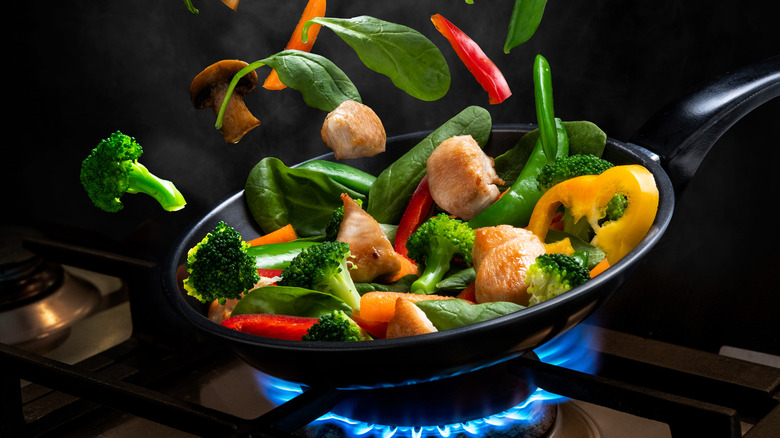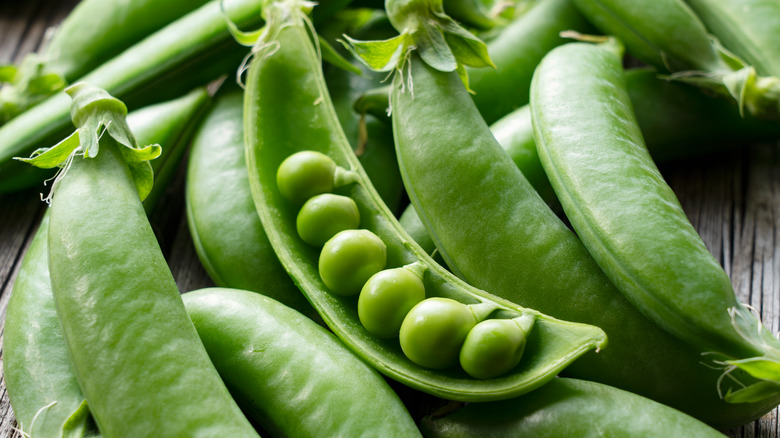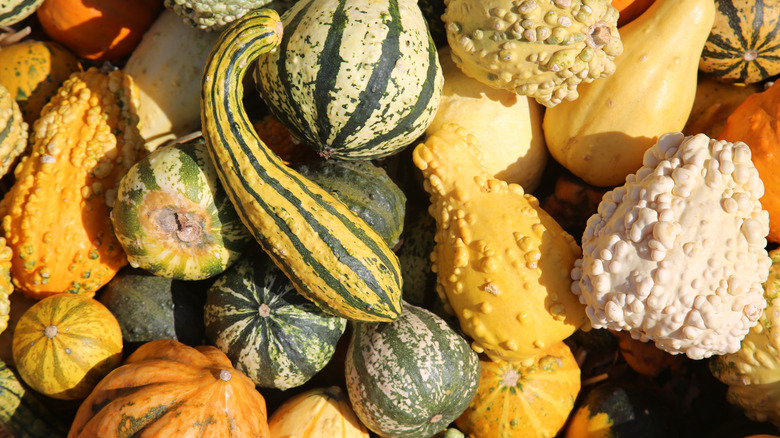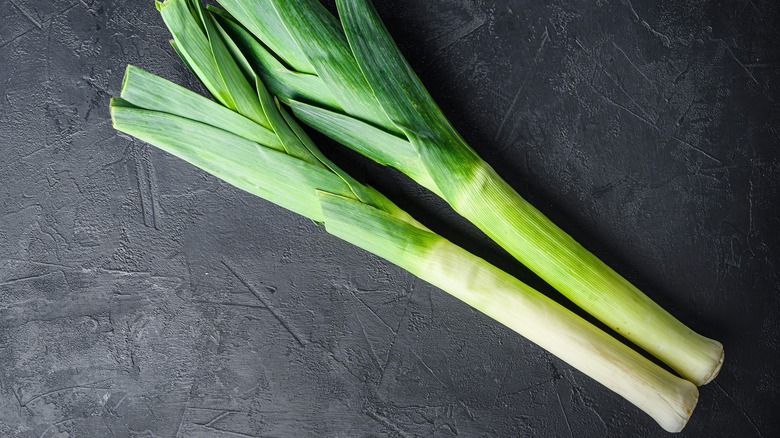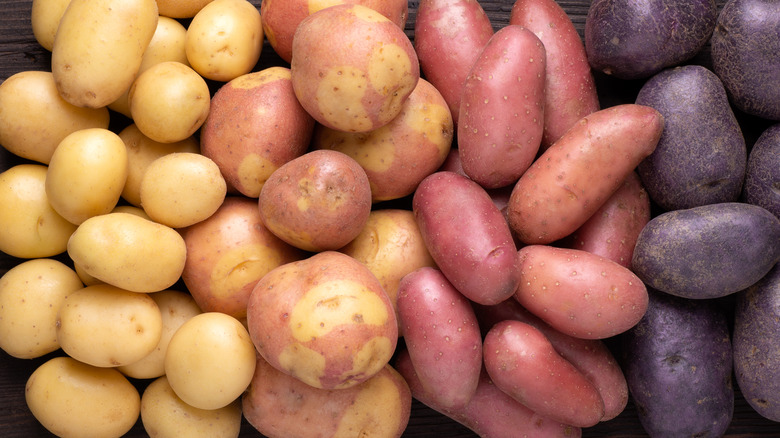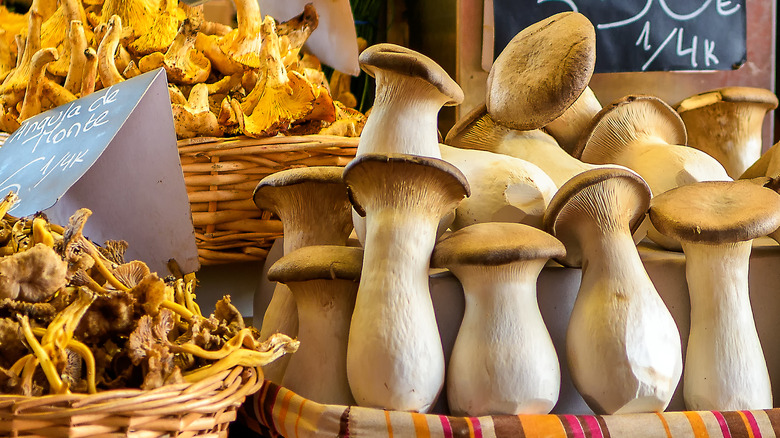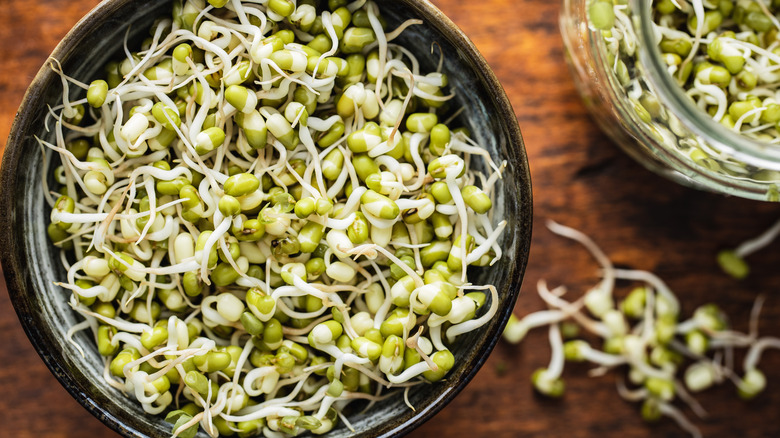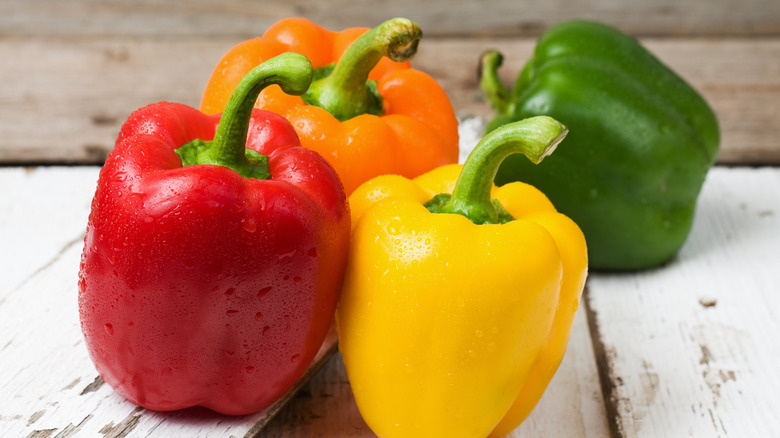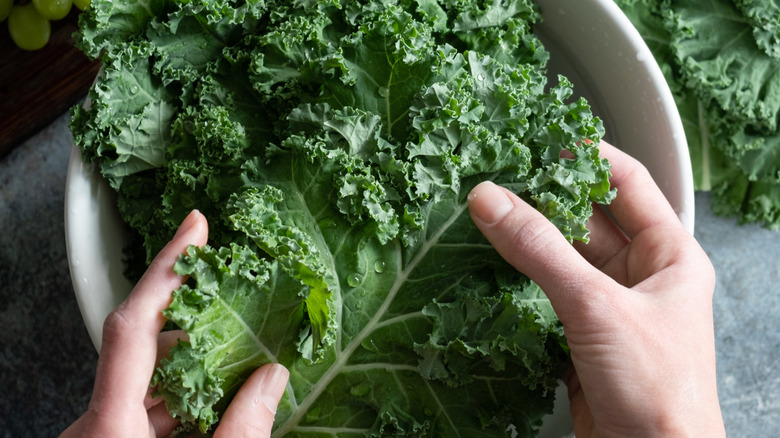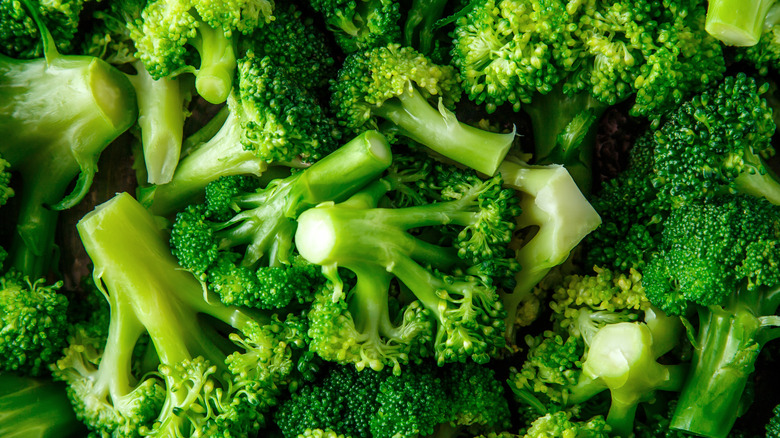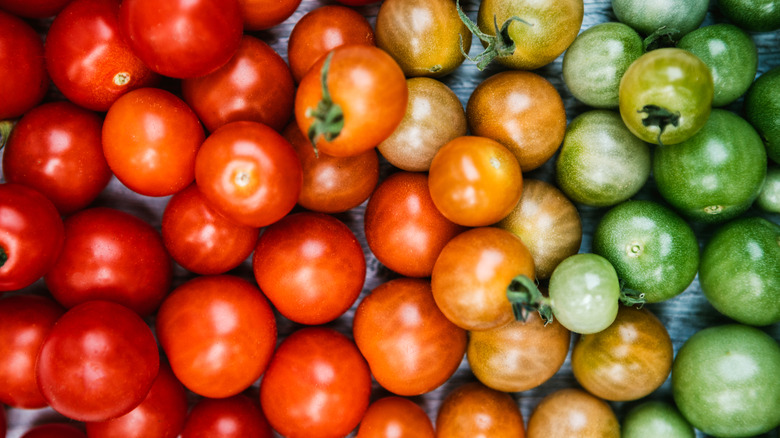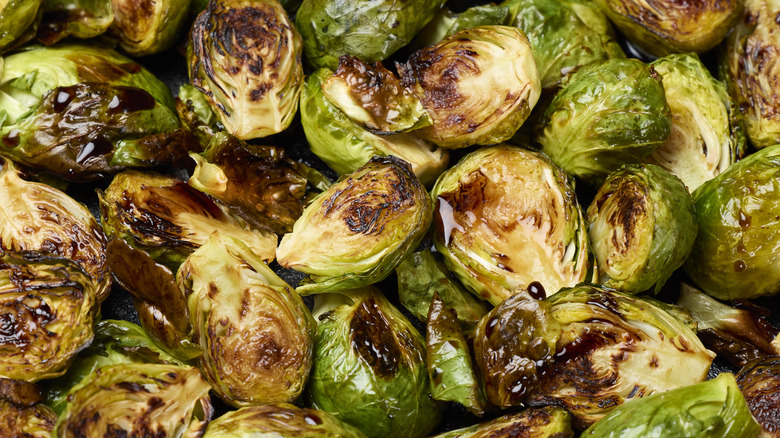Vegetables You Should And Shouldn't Be Adding To Your Stir Fry
Whether you're stir-frying beef and broccoli, shrimp and snow peas, tofu and mixed veggies, or an "on the fly" Pad Thai, stir-frying is one of the best cooking techniques around. It's quick, it's versatile, it's relatively simple, and it always creates an incredible tasting dish that's a feast for the senses.
Originally developed in China centuries ago, the process of stir-frying involves quickly cooking small pieces of meat and vegetables with a small amount of oil in a large pan over high heat. To create that iconic stir-fry flavor and appearance, the food should be constantly stirred or tossed to ensure that it is evenly cooked and does not stick to the pan and burn. It's a technique that's perfect for creating a great meal while also allowing ample room for experimentation and innovation.
Feeling like chicken and shrimp tonight? Throw them both in! Do you fancy a spicy Kung Pao sauce more than soy sauce? Pour in your favorite to taste! When stir-frying, you want to make sure your heat is as high as possible. You don't want a lot of added extra moisture in your dish — or your foods will steam instead of fry. And you want to add the foods that work best for your stir fry while avoiding the foods that will muddy or mess up an otherwise stellar creation. Some veggies fit that criteria perfectly. Others are a big miss. Read on to find out which lands in which camp.
Snow peas are a perfect stir-fry choice
With their tender texture, mild sweet flavor, and numerous nutritional high marks, snow peas are made to be stir-fried. And unlike many other veggies that lose their shape or turn mushy when cooked at high heat, snow peas are great at retaining their shape and crispness even after they've been stir-fried. Combine that with their incredible ability to pair well with all manor of other ingredients in a dish, and they're an instant no-brainer for adding to almost any stir fry.
Another plus is that because of their natural sugar, snow peas also tend to become slightly caramelized as they cook, creating a rich, savory almost umami-like flavor that adds depth to a meal. And they cook quickly and evenly, so they also don't need a lot of special care as they cook, says Karen Lee, a caterer, private chef, and cookbook author based in New York City. "Snow peas are fabulous for a stir fry," she says. The only catch? "You just have to string 'em first," she adds.
Luckily, "stringing" a snow pea — or removing the thin, fibrous string that runs the length of the pea pod — is easy. Just hold the snow pea by the stem end with one hand and the curved tip with the other hand and carefully snap off the stem end. Then gently pull the remaining "string" down the length of the pea pod and remove it. Voila, you're ready to stir fry!
Never add squash to a stir fry
Regardless of the type — butternut, acorn, spaghetti — squash is almost never a good addition to your stir fry. Using it might be tempting: squash have a delicious sweet, nutty flavor; they're high in vitamins; and they're affordable and can be grown and sourced locally. But they just don't work well in a stir-fry setting, caterer and private chef Karen Lee advises. "They're just too dense — it's better to steam or roast them," she says.
In addition to that denseness, squash also tend to have a high water content, which makes it difficult to achieve a crisp texture when stir-frying. They tend to become mushy and limp instead, which can make any stir fry way less appetizing. All that extra moisture can also dilute the flavor of other ingredients in your stir fry and water down your sauce.
The exceptions to the "no squash in the stir fry" rule are zucchini and yellow squash, two summer garden staples. They're still soggy and packed with water, but they can work in a stir fry if you take a few precautions, says Gilley Tang, a New Jersey-based chef and culinary instructor with the online cooking school giant CozyMeal. He advises dicing them into medium-sized chunks then stir-frying them separately so you don't have to deal with their extra water in your entrée. Cook them until tender, drain, and then add them to the rest of your stir fry at the end, he says.
You should always stir-fry leaks
Garlic and onions are essential ingredients in most stir fries. And if you like the strong, distinctive punch they impart into a dish, you have to try stir-frying leeks as well, cookbook author Karen Lee says.
For starters, leeks have a unique semi-sweet flavor that's part onion, part garlic — they provide the best of both worlds and also add a unique depth of flavor to stir fries that you can't get with other ingredients. Leeks also have a tender, crispy texture — even when cooked — that works incredibly well in stir fries. And they're versatile, easy to prepare, and packed with nutrients, including vitamins A, C, and K as well as folate and potassium.
"I use them even more for the nutritional value than for their taste," she adds. "Leeks are something that a lot of home cooks are not that familiar with. I teach a lot of cooking classes, and sometimes a fairly good cook will say they don't know what to do with leaks or know how to wash them or cook with them." To prep your leeks for stir frying, Lee suggests cutting the root ends off, slicing them down the middle, and then rinsing them in warm water to make sure they don't have any grit. Next, slice the cleaned leeks into thin half-moon-shaped wedges about a quarter of an inch thick. Then add them to your stir fry, and cook almost as you would an onion.
Steer clear of stir-frying potatoes
Potatoes may be a beloved staple of countless cuisines from around the world, but Chinese cooking isn't one of them. In fact, aside from an occasional stew of breakfast potato pancake, potatoes are almost unheard of in most traditional Chinese dishes — and especially when it comes to stir fries. But unlike dense, water-packed squash, the problem with potatoes when it comes to stir-frying is all that starch they pack. Cook them over high heat, and their texture quickly turns to mush. Combine that with the relative lack of flavor on their own and their ability to take on the flavors of other foods they're cooked with, and they just wouldn't bring a lot to any stir fry recipe, even if they didn't fall apart as they cooked.
And perhaps worst of all, they also take a long time to cook, so you would likely risk burning other ingredients in your stir fry while waiting for your potatoes to cook if you were to use them. "I definitely wouldn't use any potatoes in my stir fries," caterer and private chef Karen Lee says.
Natasha Ford, a New York City-based chef and culinary instructor who teaches with CozyMeal, agrees. "I wouldn't put regular potatoes in a stir fry either," she says. "Beyond the mushiness, they also compete with noodles or rice, and you never want too many starches in a dish." When it comes to Chinese cooking, think of these vegetables as "Tater Nots."
Definitely add mushrooms to your stir fry
All of our experts agree: Mushrooms are a must-have when it comes to stir-frying. "I love mushrooms, and I think mushrooms do really well in stir fry," chef Natasha Ford tells us. "With their flavor and texture, they're especially great if someone is trying to convert into a vegan or vegetarian lifestyle and wants to cut out meat."
Chef and culinary instructor Gilley Tang professes a love for stir-frying a variety of mushroom types, including shiitakes, portobellos, button, hen of the woods, and maitakes. They're classics for stir fries, and you can use more than one to layer in the flavors, he says.
Chef Karen Lee even has some favorite strategies in place to deal with the extra wateriness that mushrooms sometimes impart. For starters, she says, if you buy mushrooms and plan to use them within the next couple of days, remove the saran wrap from their package when you put them in the fridge. "Mushrooms need to breathe," she says. "If you store them like this before cooking, they don't give off as much water and are easier to stir-fry." Another of her favorite suggestions? Sauté your mushrooms separately to cook off some initial water, then add them to your stir fry near the end. "Mushrooms have much more flavor if they're sautéed and then added," she says. "Or what I usually do is sauté them and then use them as a topping at the end." Delish!
Don't make the mistake of stir-frying bean sprouts
Bean sprouts definitely have their fans — there are folks that love them on everything from hearty sandwiches to fresh green salads to hot or cold soups where they add a sweet, nutritious bit of crunch. But the experts we spoke to all agree that they can be a challenging ingredient for chefs of any experience level to successfully add to a stir fry. Cook them wrong or cook them too long, and they basically turn to a soggy, crunch-free ball of mush.
"You can sauté them and serve them on top of a finished stir fry," chef Karen Lee says, "but if you just dump them in as you cook, they can leave a chalky, undesirable flavor." They're also a challenge to keep on hand fresh, she adds. "You want them snow white," she advises. "When they start turning brown, they're no good — you just need to throw them away."
Chef Gilley Tang says the short shelf life is one of his biggest problems with bean sprouts. "If you don't cook them right away and let them sit in the fridge, they're gonna spoil — they turn moldy and spoil really quickly." He also doesn't like their ample moisture content, saying they tend to muddy a stir fry and turn it watery as soon as they're added. "Bean sprouts for me are a definite stir-fry no-no," he says.
Bell peppers are a great stir-fry addition
Like onions and mushrooms, bell peppers are one of the most classic and essential of all vegetables you can add to a stir fry. It doesn't matter the color of the pepper you select or how you dice them — big and chunky or just under bite-sized — these sweet, tangy orbs always belong. Their flavor pairs naturally with almost any stir-fry combination you might throw together, and they add a bright, fresh taste to any dish they are included in.
Even better than the taste they impart, fresh bell peppers also add incredible crunch to any stir fry because of their firm, crisp texture. And their bright and versatile colors also help to add visual appeal to your meal — an important trait to always keep in mind since we eat (and appreciate) meals with our eyes and well as with our taste buds.
"Bell peppers are one of those things that I would just say taste great in a stir fry," chef Gilley Tang enthuses. "Peppers have that little bit of extra water content in them, so when you bite into one as part of a stir fry, they cut the richness of the other ingredients you are cooking, and they cut the saltiness and the fattiness of those other foods." Best of all, they also enhance the sweetness and brighten the dish at the same time, he says. Stir-fry perfection!
Dark leafy greens like kale are better in other recipes
Leafy greens like kale, Swiss chard, and bok choi definitely have a place in some stir fries, but their inclusion is also an incredible matter of personal taste. Many people — our experts included — just don't like them in stir fries. For starters, they can be bitter tasting and overpower a dish. They can also become tough and chewy or soggy and slimy depending on the green and how long they are cooked in your stir-fry recipe. Chef Gilley Tang says the wateriness of leafy greens is the biggest deal-breaker for him, since they instantly become soggy and can really weigh down a stir fry with added moisture.
For chef Natasha Ford, she says leafy greens in a stir fry are a matter of preference, but she doesn't like to use them in her recipes. "The texture of leafy greens can just be a little off for me in a stir fry," she says. "Like for instance, I wouldn't necessarily put bok choi in a stir fry unless I was using mostly the white part of it. I don't like how the leaves kind of have that slimy feel after they're cooked."
Chef Karen Lee says, "I love dark leafy greens, but I wouldn't choose kale or a chard or mustard greens or collard greens for a stir fry. I would braise or sauté them with some garlic for a side. I don't use those greens for stir-frying."
Or course, broccoli is a stir-fry superstar
Of all the vegetables you can add to a stir fry, broccoli is perhaps the most loved among diners and chefs alike. It's got the stellar nutritional profile and is a good source of fiber as well as vitamins and minerals, including vitamin C, vitamin K, folate, and potassium. It's got the ideal flavor profile for a stir fry — a little bit sweet and a little bit bitter without being too overpowering when combined with other ingredients. It's colorful. It's crunchy. And it holds up to being cooked at high temperatures, becoming soft without turning overly mushy.
"I've really come to appreciate broccoli over the years," chef Gilley Tang says. "It doesn't leak out too much water, and it has the structural content to hold up once a sauce is added to your stir fry. And it just tastes great with soy and sesame — that combination. It's perfect for stir-frying."
For the best-tasting broccoli in a stir fry, chef Karen Lee recommends always taking a couple extra minutes to blanch fresh broccoli before adding it to your wok or skillet. Just bring a couple cups of water to a boil, and then submerge your broccoli spears in the boiling liquid for 20-30 seconds and remove them. Blanching helps to break down the denseness of the broccoli, so it cooks more evenly and becomes more tender in your stir fry, she says. It's a little step, but it makes a difference you can taste!
Tomatoes are a stir-fry disaster
Tomatoes are not traditionally used in Chinese cuisine, so aside from some rare one-off dishes like sweet and sour pork, you'd be hard-pressed to find very many tomatoes in stir-fry recipes. And the reason, at this point, should be obvious: They're just too darn moist and filled with too much water. When you stir-fry tomatoes, they water down the oil and other foods you're trying to cook them with, so your ingredients end up steaming instead of frying. And they're also no good at holding up to high cooking temperatures. They're great if you live in Italy and are trying to simmer up some pasta sauce (or "gravy" as the locals tend to call it). But if you're making a quick stir fry, dissolving tomatoes aren't going to be high on your must-use list.
Tomatoes in stir fries get a big no from chef Karen Lee. "I'd never use them in one," she says. "No, no, no, no," chef Gilley Tang agrees. "Tomatoes should never go in a stir fry — not at all."
Chef Natasha Ford adds that they're too mushy. "They would just make your stir fry soupy," she says. "If you really want to use them, keep them as fresh and uncooked as possible. Maybe dice them up and use them as a garnish on top of your finished stir fry, but I'd never add them to a stir fry."
Finally, don't forget to add Brussels sprouts to your stir fry. They're an unexpected must!
Stir fries are a great way to be inventive and try new things! And even if you shouldn't add squash or potatoes or tomatoes to your fantasy stir fry, there's plenty of other produce out there that works great in a stir fry, including eggplant, asparagus, bamboo shoots, water chestnuts, celery, carrots, corn, cauliflower, and even fennel! The list doesn't stop there. One highly non-traditional stir-fry ingredient that chef Gilley Tang swears by is something you might never associate with Chinese cooking — the often misunderstood Brussels sprout!
"I love Brussels sprouts in stir fries," he says. "They're especially great when you're cooking Chinese at home because they can help you to create that intense wok flavor we all want in our stir fry."
Tang explains that when Brussels sprouts stir-fry, they char around the bottom of the skillet — and that caramelization creates a smell and flavor very similar to the one you get from Chinese food cooked over a powerful commercial stove, which uses a much higher temperature than a home stove. When he teaches Chinese cooking, Tang says he shows his students how to recreate authentic flavors and smells. And that's what you get stir-frying Brussels sprouts — the taste of a wok and a Chinese restaurant right in the comfort of your home. They're a must try, he says!
